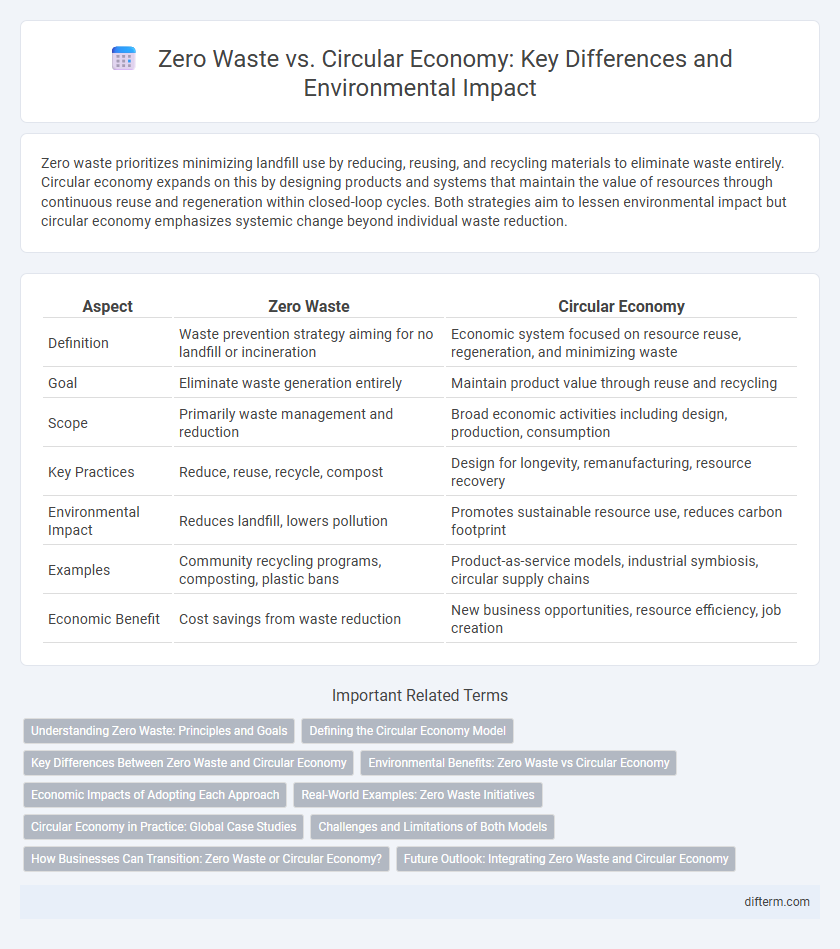Zero waste prioritizes minimizing landfill use by reducing, reusing, and recycling materials to eliminate waste entirely. Circular economy expands on this by designing products and systems that maintain the value of resources through continuous reuse and regeneration within closed-loop cycles. Both strategies aim to lessen environmental impact but circular economy emphasizes systemic change beyond individual waste reduction.
Table of Comparison
| Aspect | Zero Waste | Circular Economy |
|---|---|---|
| Definition | Waste prevention strategy aiming for no landfill or incineration | Economic system focused on resource reuse, regeneration, and minimizing waste |
| Goal | Eliminate waste generation entirely | Maintain product value through reuse and recycling |
| Scope | Primarily waste management and reduction | Broad economic activities including design, production, consumption |
| Key Practices | Reduce, reuse, recycle, compost | Design for longevity, remanufacturing, resource recovery |
| Environmental Impact | Reduces landfill, lowers pollution | Promotes sustainable resource use, reduces carbon footprint |
| Examples | Community recycling programs, composting, plastic bans | Product-as-service models, industrial symbiosis, circular supply chains |
| Economic Benefit | Cost savings from waste reduction | New business opportunities, resource efficiency, job creation |
Understanding Zero Waste: Principles and Goals
Zero waste emphasizes eliminating waste by redesigning resource life cycles to ensure all products are reused, recycled, or composted, minimizing landfill contributions. Principles include reducing consumption, maximizing product lifespan, and promoting sustainable materials management to achieve a closed-loop system. The ultimate goal is to create a society where waste generation is minimized, conserving natural resources and reducing environmental pollution.
Defining the Circular Economy Model
The circular economy model focuses on designing products and systems to maximize resource efficiency by reusing, refurbishing, and recycling materials, thereby minimizing waste generation. Unlike the zero waste approach that primarily emphasizes eliminating waste through prevention and reduction strategies, the circular economy integrates economic growth with environmental sustainability by keeping materials in continuous circulation. This model fosters innovation in product design, supply chain management, and consumer behavior to create closed-loop systems that reduce environmental impact and conserve natural resources.
Key Differences Between Zero Waste and Circular Economy
Zero waste focuses on eliminating waste by redesigning products and processes to ensure all materials are reused or recycled, minimizing landfill impact. Circular economy emphasizes systemic change across production, consumption, and resource management to create a closed-loop system where materials continuously flow back into the economy. The key difference lies in zero waste targeting waste prevention at the product level, while circular economy integrates broader economic models for sustainable resource use and regeneration.
Environmental Benefits: Zero Waste vs Circular Economy
Zero waste aims to eliminate waste by redesigning resource life cycles, minimizing landfill use, and reducing pollution, which significantly lowers greenhouse gas emissions. Circular economy extends beyond waste reduction by promoting continuous material reuse, fostering innovation in sustainable product design, and enhancing resource efficiency across entire supply chains. Both models contribute to conserving natural resources and mitigating environmental degradation, but the circular economy offers a more systemic approach to achieving long-term ecological balance.
Economic Impacts of Adopting Each Approach
Adopting a zero waste approach can reduce raw material costs and minimize landfill expenses by emphasizing waste elimination through reuse and recycling. The circular economy drives economic growth by creating new business opportunities and jobs in sustainable product design, resource recovery, and remanufacturing sectors. While zero waste primarily targets cost savings and waste reduction, the circular economy fosters broader economic resilience by integrating sustainability into the entire supply chain and value creation processes.
Real-World Examples: Zero Waste Initiatives
Zero waste initiatives in cities like San Francisco and Kamikatsu, Japan, have successfully reduced landfill waste by implementing community-wide recycling, composting, and reuse programs. These real-world examples demonstrate how targeted local policies and public engagement foster sustainable resource management aligned with circular economy principles. Emphasizing practical zero waste efforts showcases measurable environmental benefits while supporting a shift from linear consumption patterns to regenerative systems.
Circular Economy in Practice: Global Case Studies
Circular economy in practice emphasizes resource efficiency through closed-loop systems and innovative recycling technologies, as demonstrated by global case studies in cities like Amsterdam and Tokyo. These examples highlight reduced landfill use, enhanced product lifecycle management, and robust waste-to-resource transformations that surpass zero waste initiatives. By prioritizing systemic redesign and stakeholder collaboration, circular economy frameworks drive sustainable urban development and carbon footprint reduction worldwide.
Challenges and Limitations of Both Models
Zero waste initiatives face challenges such as limited consumer participation and inadequate recycling infrastructure, which hinder their effectiveness in waste reduction. Circular economy models are constrained by technological gaps, high implementation costs, and the complexity of redesigning supply chains for resource recovery. Both approaches struggle with regulatory inconsistencies and the need for widespread industry collaboration to achieve scalable environmental benefits.
How Businesses Can Transition: Zero Waste or Circular Economy?
Businesses can transition to sustainability by adopting zero waste strategies, which prioritize eliminating landfill waste through efficient resource management and recycling. Embracing the circular economy model extends these efforts by redesigning products and supply chains to maintain the value of materials through reuse, remanufacturing, and closed-loop systems. Integrating circular economy principles drives innovation, reduces raw material dependency, and enhances long-term economic resilience.
Future Outlook: Integrating Zero Waste and Circular Economy
Integrating zero waste principles with the circular economy framework drives sustainable resource management by minimizing waste generation and maximizing product lifecycle value. Emerging technologies like advanced recycling methods and digital tracking systems enhance material recovery, supporting closed-loop industrial processes. Policy shifts emphasizing producer responsibility and consumer awareness ensure scalable adoption of these synergistic approaches, fostering resilient, low-impact economies.
zero waste vs circular economy Infographic

 difterm.com
difterm.com